27 IUD Experiences That Prove We Need Better Birth Control Now
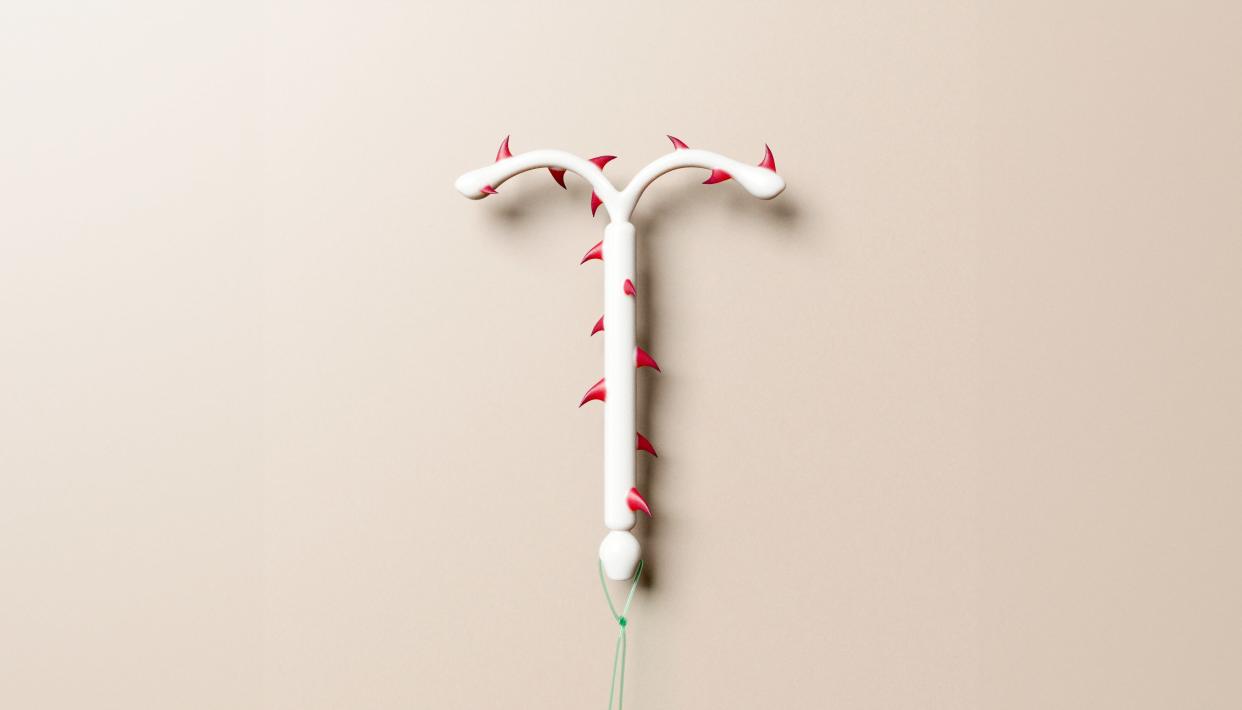
Pregnancy isn’t an option, I thought, breathing through the pain of getting an intrauterine device (IUD) inserted into my uterus. After evaluating my choices with my ob-gyn (the pill seemed too hard to keep up with; condoms too unreliable), I got an IUD called Mirena during my first year of college to help me get through school without worrying about a surprise pregnancy.
An IUD is a flexible, T-shaped device with strings tied to the end. Its shape helps it sit in your uterus—the arms of the “T” anchor it into place. It’s tiny—between 1.18 to 1.42 inches long, which is about the size of a standard paperclip—but powerful. Hormonal IUDs—you might know them by their brand names, like Mirena, Liletta, Skyla, and Kyleena—release progestin, a synthetic form of the hormone progesterone, to alter the menstrual cycle, suppress ovulation, and stimulate mucus in the uterus (which helps keep sperm from traveling to the egg). There are also nonhormonal IUDs, like Paragard, in which copper acts as a spermicide. In either case, the IUD is more than 99% effective in preventing pregnancy, making it one of the most effective forms of birth control. It’s not something you have to remember to take (like the pill or an injection). You’re not supposed to feel it in your body (like you would a birth control implant in your arm). And most health insurance plans cover both hormonal and nonhormonal IUDs. Mine did, entirely.
For me, this was a godsend. As a child of immigrants and one of the first in my family to enroll in college in the US, I was under immense pressure to get a quality education and degree. By the time I moved into my dorm room, I had only one parent to help me reach that goal and with the many uncertainties of that time (like, if I could make my tuition payments by each deadline), one thing was for certain: A baby would make my situation much harder.
So there I was in stirrups, breathing through sensations I’d never felt before. Sure, my doctor warned me that I might feel cramping pain. Yes, I took two ibuprofen before the appointment, as instructed. Still, I shed a few tears. But the discomfort was worth it. My IUD helped protect me from pregnancy through my college years and beyond. I was proud of my decision to take charge of my reproductive health and safety. When it was time for the Mirena to come out (at the time, the FDA recommended removal after five years, as opposed to today’s eight-year lifespan), I immediately made an appointment to replace it.
My second IUD didn’t last as long. As I found out later during a consultation with a different doctor, it was placed incorrectly, making it feel like my insides were being shredded. To a degree, they were: The device was scraping against my uterus and I was left with scar tissue that my doctor said might require surgery to remove when I ultimately want to conceive. (This condition is called Asherman’s syndrome, she told me.)
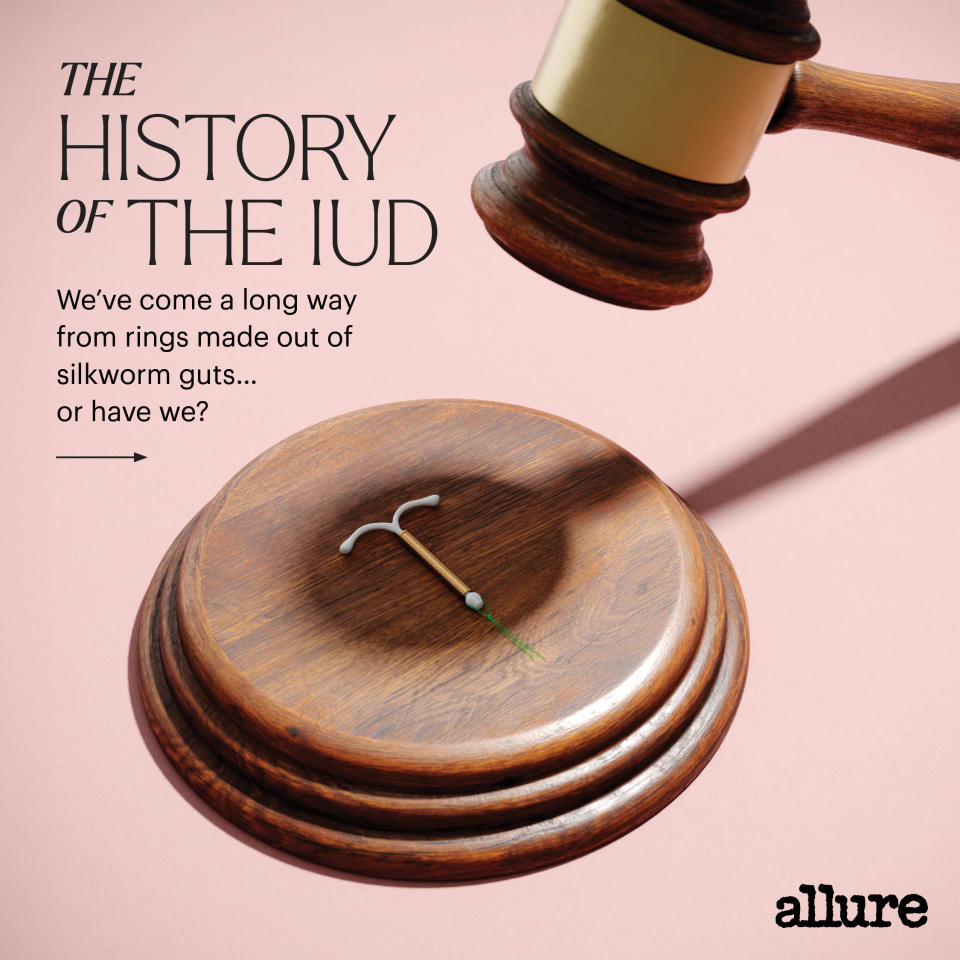
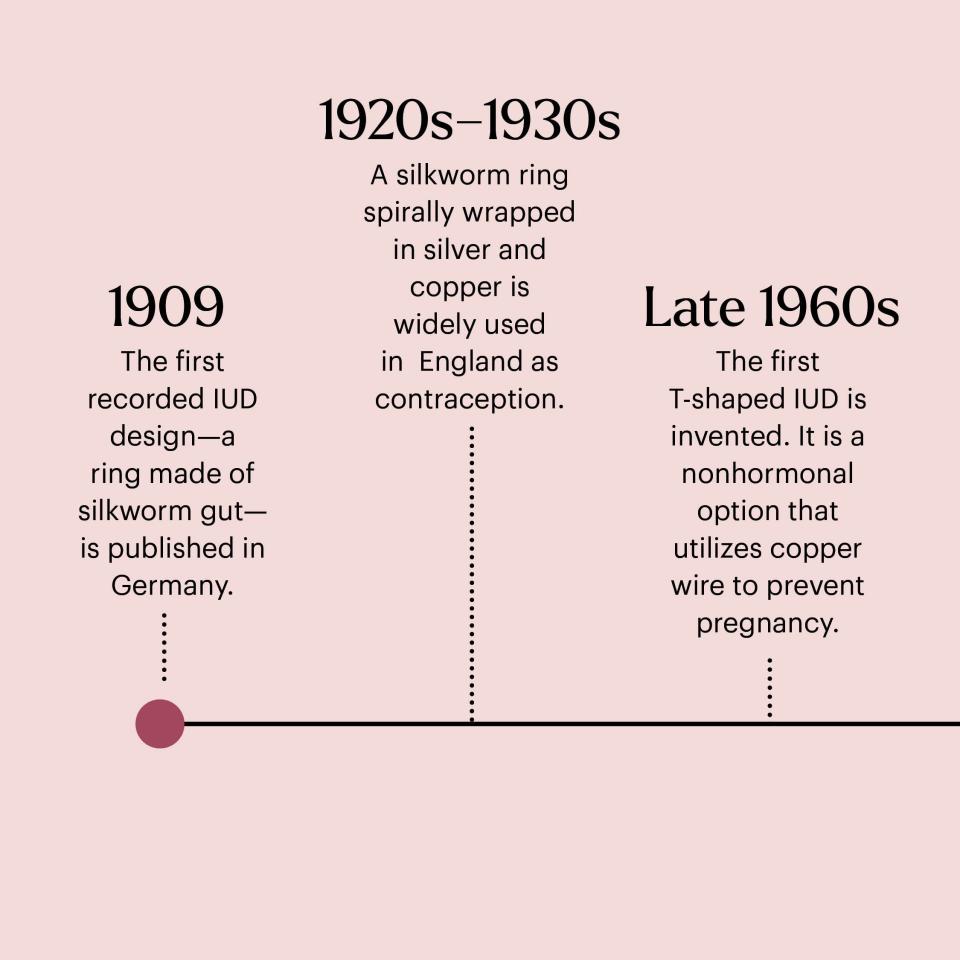
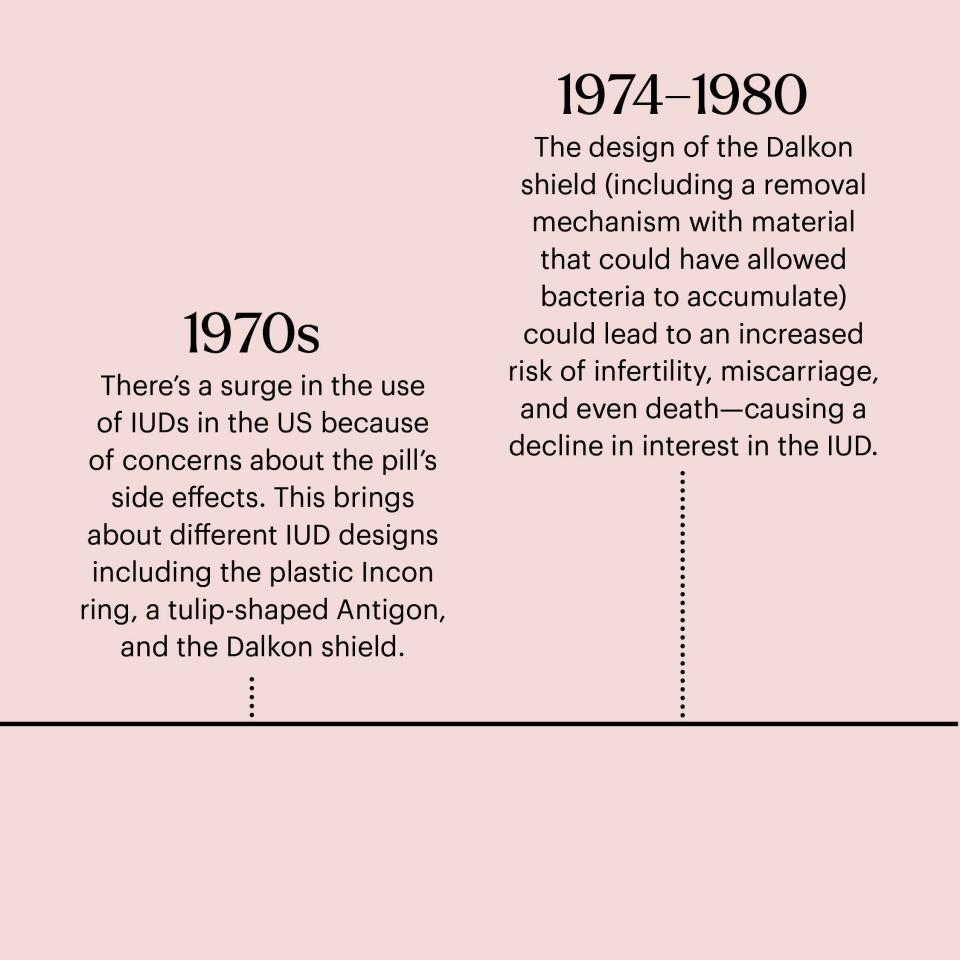
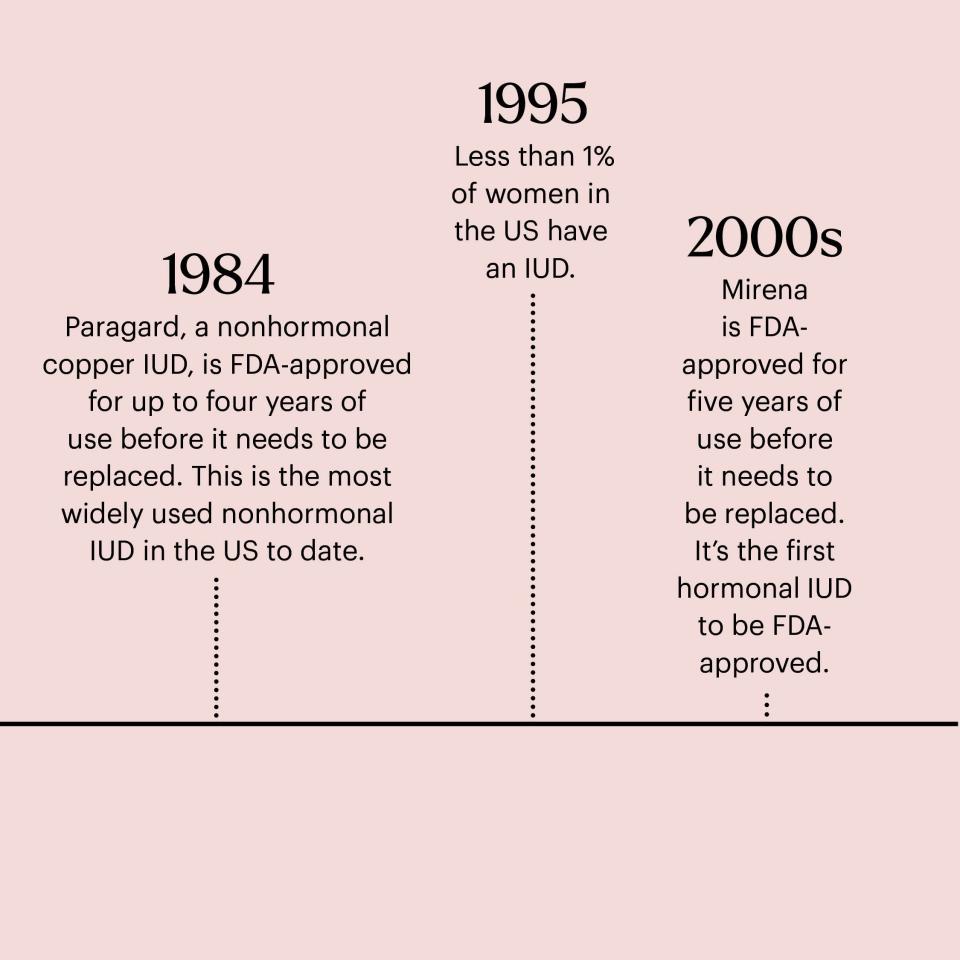
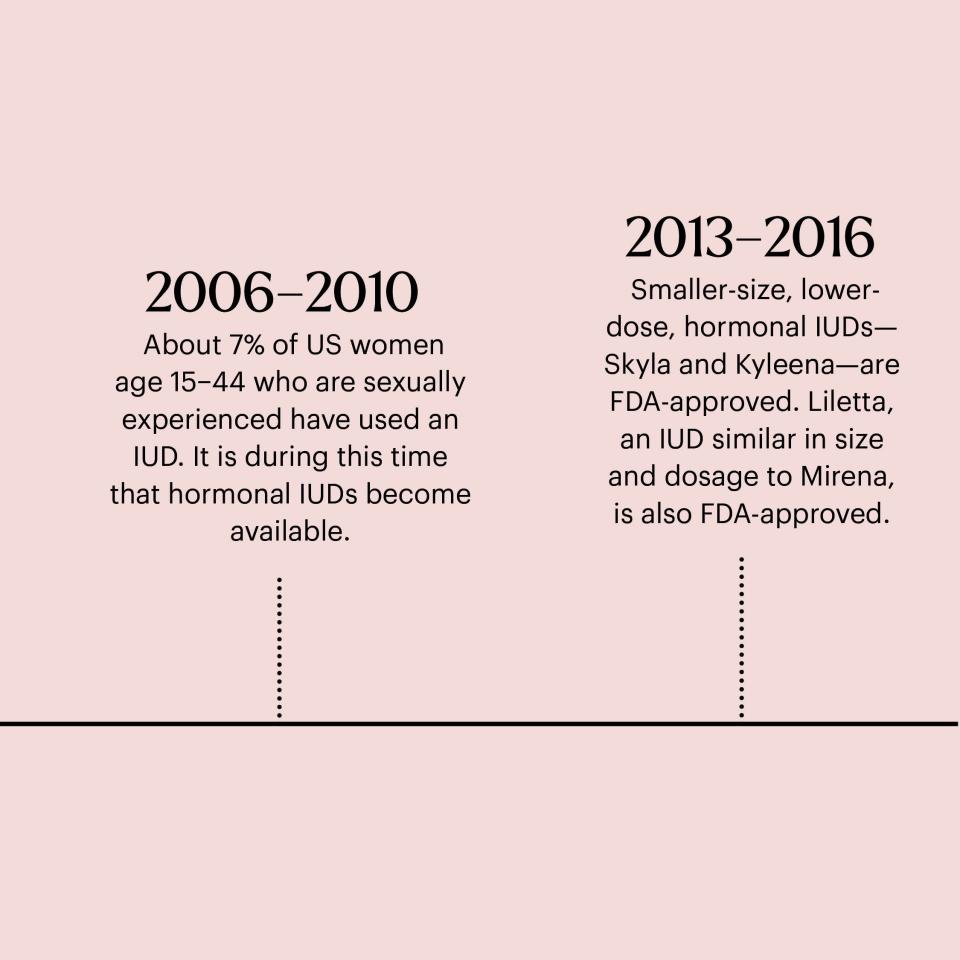

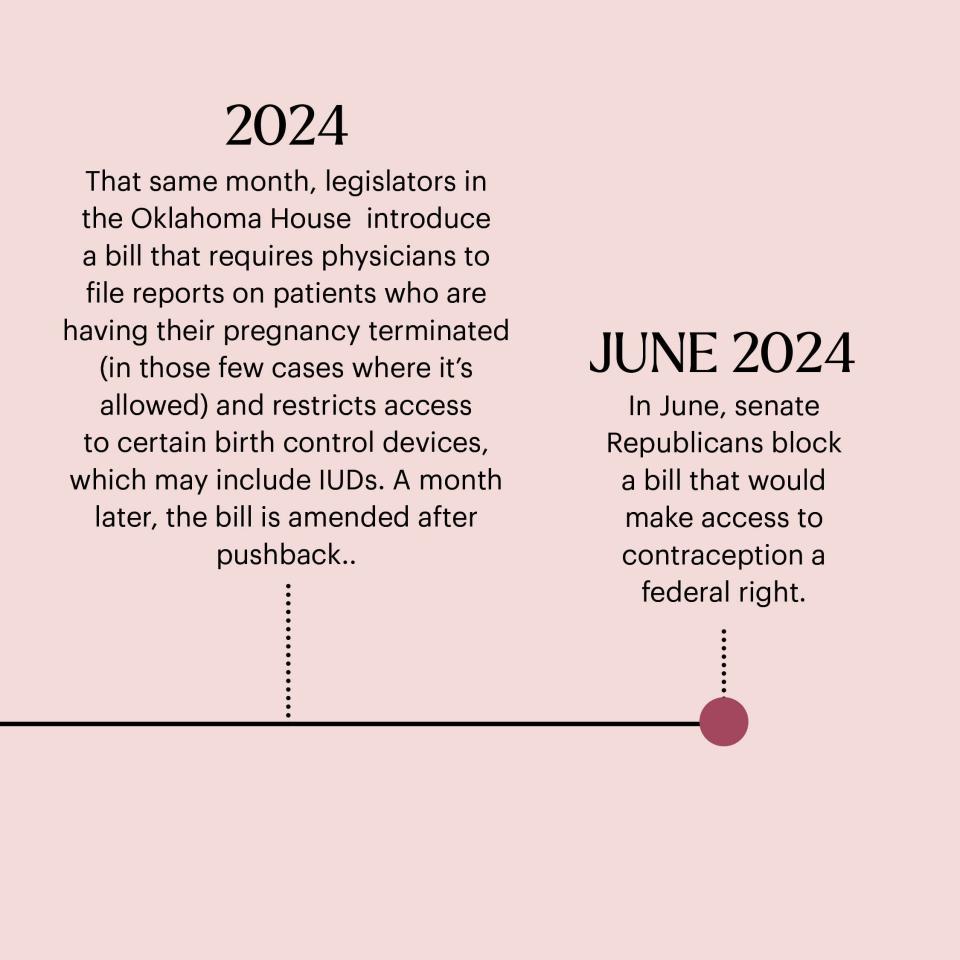
Despite this, if you asked me if I regret getting either of my IUDs, I’d answer with an unequivocal no. It’s not so cut-and-dried for others—which is why Allure set out to collect a range of stories from IUD users, past and present. Like many aspects of reproductive health, IUDs are generally under-discussed and under-researched, despite there being undeniable benefits to talking about the nuances of the procedure. “From a medical professional’s perspective, personal accounts help fill in the gaps that clinical data and health-care providers might miss,” says Lucky Sekhon, MD, a double board-certified reproductive endocrinologist, infertility specialist, and ob-gyn at the fertility clinic RMA of New York. From a patient’s perspective, these stories can help with expectation-setting, anxiety management, and decision-making.
Some of those we spoke to gushed about painless appointments and how afterwards they never gave their IUD another thought. Others said they had agonizing cramps and bleeding both during and long after insertion. It seemed like there was no universal experience—good or bad.
Why is that? Certainly, other forms of contraception—especially those for men (like a vasectomy)—don’t have quite as many variables. Numerous factors influence a person’s IUD experience, including anatomical differences, says Dr. Sekhon. Uteruses come in all different shapes, sizes, and orientations. “A retroverted uterus, where the cervix tilts backward, is one variation that can make the IUD insertion process more challenging and potentially more painful,” she says.
Personal medical history can also have an impact. For example, if you have a history of uterine fibroids, you might have a harder time with your IUD as fibroids can impact the insertion or positioning, says Dr. Sekhon.
Then, there’s your pain threshold. The procedure can prompt a range of sensations from a dull cramping to pain that can trigger a vasovagal response (when your blood pressure and heart rate suddenly drop, causing nausea, sweating, lightheadedness, and, in some cases, fainting). A study conducted at Cornell University found that 78% of participants experienced what they characterized as “moderate to severe pain” during IUD insertion. “The skill and experience of the health-care provider performing the insertion, the specific type of IUD, and the patient's level of anxiety or stress during the procedure can also play significant roles,” adds Dr. Sekhon.
In August 2024, the C.D.C. released updated recommendations for contraceptive use, including IUDs. It acknowledges the pain some people with uteruses experience during and after placement and encourages medical professionals to keep their patients’ mental health (including conditions like anxiety) and past traumatic experiences in mind. Says the organization in its recent report, “A person-centered plan for IUD placement and pain management should be made based on patient preference.” It also urges health care providers to consider a patient’s concern about pain during placement as a barrier to IUD use.
There are a few steps you can take to help ensure a more comfortable appointment. First and foremost, ask questions. You should consider writing down your concerns ahead of the appointment so you can reference them when the time comes, says Tia Jackson-Bey, MD, MPH, a double board-certified reproductive endocrinologist, infertility specialist, and ob-gyn at RMA of New York: “This will help you remember everything you want to discuss.”
Many of the people Allure spoke to wished their doctors had been more forthcoming about options for pain management. In an ideal scenario, options for mitigating pain “should be a standard part of pre-procedure discussions,” says Dr. Sekhon. The reason these discussions might not be taking place can vary, she says, and may include “assumptions about pain tolerance, a lack of awareness among providers, and systemic issues within health-care settings that fail to emphasize patient-centered approaches.” Also, insurance may or may not cover certain forms of pain management.
While over-the-counter pain relievers like ibuprofen and acetaminophen are usually suggested, some patients may be prescribed medications to make the insertion process smoother, says Dr. Jackson-Bey. (Previously, misoprostol had become more widely prescribed, but the C.D.C’s August 2024 guidelines no longer recommend routine use of the drug for IUD placements because evidence does not suggest it reduces pain or adverse effects and may, in fact, increase pain during the procedure.) A local anesthetic injection to numb the cervix or a paracervical block, which involves injecting anesthetic around the cervix are other possibilities. Vaginal inserts, such as lidocaine gel, can also be used to numb the area, says Dr. Sekhon.
“Be clear and specific when communicating your needs and expectations to your health-care provider,” says Dr. Jackson-Bey. “If something is unclear, don’t hesitate to ask for more information. It’s important that you fully understand the process. If you feel uncomfortable or believe your concerns aren’t being addressed adequately, let your provider know.” If you’re still not being heard, remember that it’s also okay to leave.
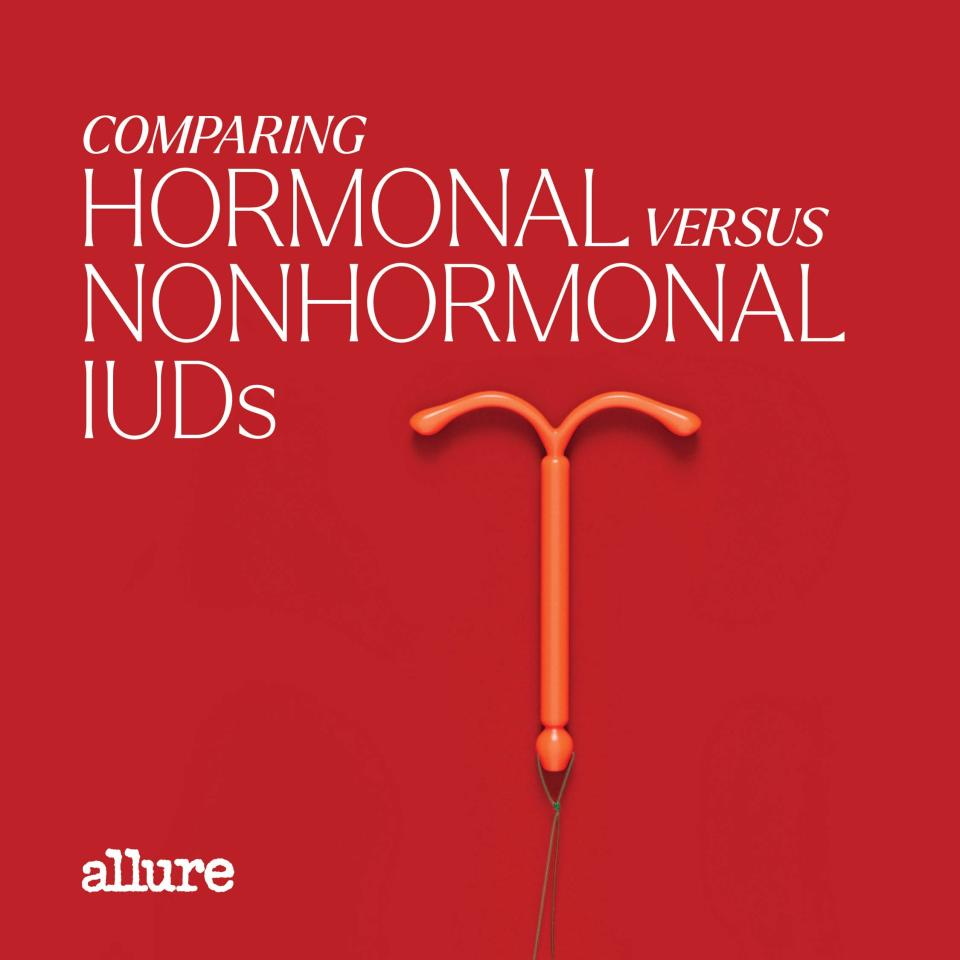
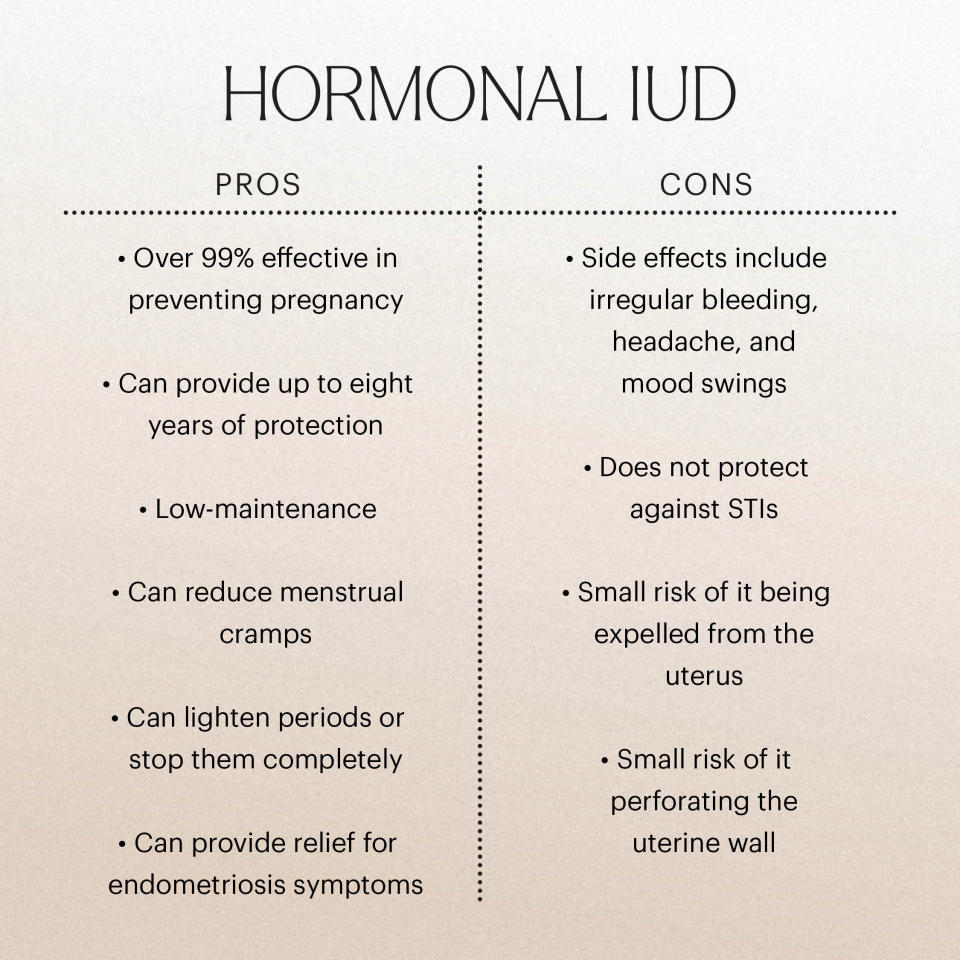
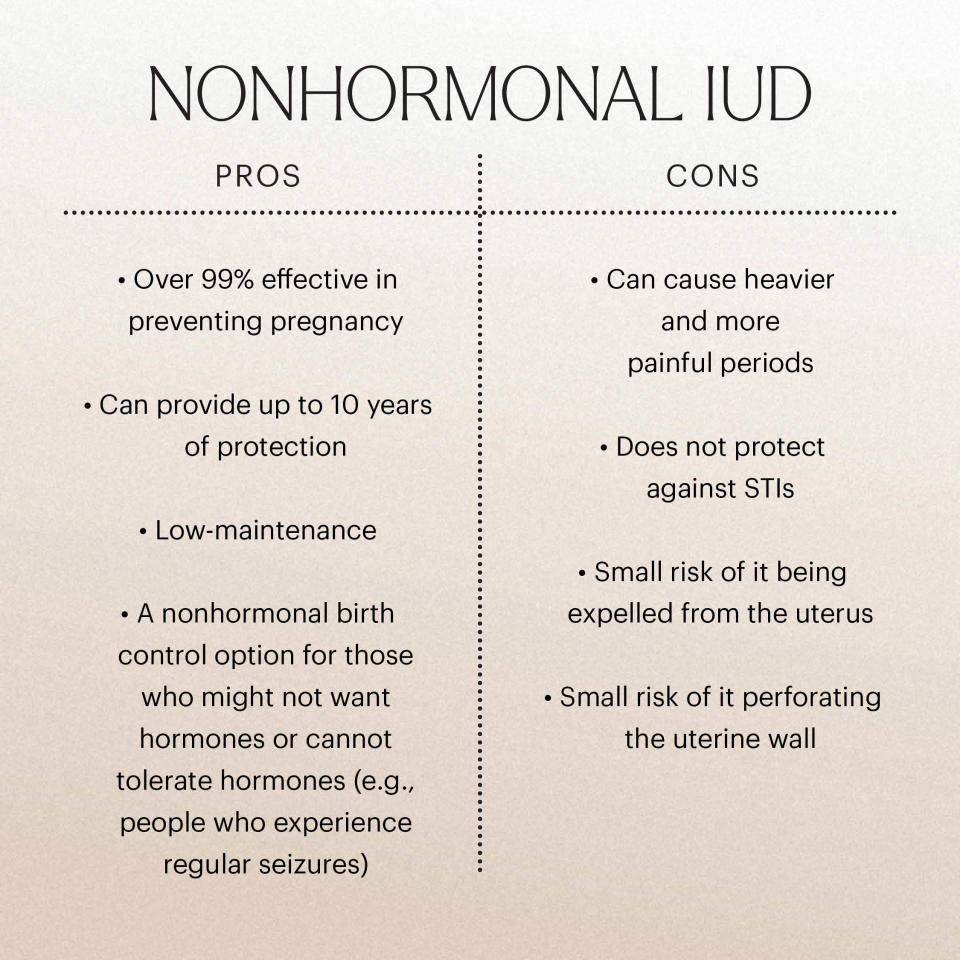
Most standard IUD insertion procedures go something like this: You undress from the waist down and put your legs up in stirrups. A speculum—a device that expands up to two inches to help hold a hollow area open—is inserted into the vagina to allow access to the cervix. Your doctor will then measure the depth of your uterine cavity to confirm the exact placement of the IUD. (You might feel some cramping here.) Next is the actual insertion. Your doctor will insert the device into your uterus using a flexible tube. (This is where you’ll feel the most uncomfortable.) Once the tube is removed, your IUD is in place, and your doctor will trim its strings before removing the speculum.
You might feel cramping or discomfort for the next 24 to 48 hours, during which time most doctors suggest refraining from sexual activity to reduce the risk of infection. For some people, this time can mark the start of when problems arise. “While IUDs are typically safe and effective, they do come with risks,” says Dr. Sekhon. Some patients experience spotting between periods and unexpected changes in menstrual flow. If you’re using a nonhormonal IUD, you will still get your period; hormonal options will stop your period entirely. Others, she says, might develop ovarian cysts, which can be painful (and make sex extremely uncomfortable) or feel like nothing at all. These cysts are typically benign, asymptomatic, and frequently found incidentally during routine check-ups, according to Dr. Sekhon. They also often resolve without the need for treatment. Still, it’s estimated that between about 5% and 22% of patients with hormonal IUDs develop ovarian cysts at some point, depending on the brand of IUD they use.
There’s also a slightly higher risk of infection in the first few weeks after insertion (as bacteria can enter your body during the procedure). And remember: IUDs prevent pregnancy, not STIs. “Those with multiple sexual partners are at an increased risk for sexually transmitted infections, which can cause complications like pelvic inflammatory disease when an IUD is in place,” Dr. Sekhon says, emphasizing the importance of always using condoms and getting regular STI screenings if you have multiple partners, regardless of when you got your IUD.
Despite the risks—and the stories you’ll read from those who’ve experienced horrific side effects, like their IUD scraping the sides of their uterus (as mine did) and heavy bleeding—IUDs continue to rise in popularity. According to the National Center for Health Statistics, the number of women who had ever used IUDs in 2019 was nearly triple that of 2010.
Many women cite their reproductive rights and the desire to maintain autonomy over their bodies as reasons why they got their long-lasting IUDs, as opposed to the daily birth control pill which comes with a prescription that typically has to be renewed every year. “I got my first IUD in 2016 after Donald Trump was elected president,” Gloria Y., a 38-year old living in Los Angeles, told Allure. Seven years later, “with women's reproductive rights being stripped from state to state…I am worried about access and affordability to birth control again.” After the first 30 days of Trump being in office in 2017, the insertion rate of IUDs rose 21.6% (from 13.4% to 16.3% per 100,000 women) according to a study out of Brigham and Women’s Hospital in Boston.
The motivation behind this spike in procedures was, presumably, the possibility—even a faint one—of a return to the reality of being a premenopausal American before 1965, when the Supreme Court made birth control a constitutional right (only for married couples, mind you). In the February 2017 issue of Allure, journalist Lindsy Van Gelder wrote about that time: “Procuring [birth control] was a little like scoring drugs. I discreetly asked around, and a friend gave me the name of a doctor in Manhattan who was reputed to be sympathetic. Per my friend’s instructions, I lied and said I was 21 and engaged to be married soon.” It would be seven more years before the right to use birth control was extended to unmarried people. In her essay, “A Letter to the Young Women of 2017,” Van Gelder wrote: “For my generation, legal access to birth control…put us in a place of independence to demand more and better. Those who don’t want you empowered know this.”
There are also reasons aside from birth control that people might choose to use an IUD. “Certain IUDs, particularly hormonal ones, can help manage heavy menstrual bleeding, reduce menstrual cramps, and improve symptoms of endometriosis,” says Stephanie Hack, MD, a board-certified ob-gyn based in the DC area and host of the Lady Parts Doctor podcast. They can also act as hormone therapy for those who are perimenopausal and help manage conditions like adenomyosis (in which the lining of the uterus grows into the uterine wall) and precancerous endometrial lesions.
“Research suggests that hormonal IUDs, particularly those releasing levonorgestrel, may contribute to a reduced risk of ovarian cancer,” says Dr. Sekhon, who cites a study out of McGill University published in 2020 that found IUDs reduce that risk by an average of 30%. “The precise mechanisms behind this reduction are not yet fully understood,” she adds. (IUDs that release levonorgestrel include Skyla, Kyleena, Liletta, and Mirena.)
In the last 50 years or so, IUDs have improved with more sizes (the smaller Skyla and Kyleena were approved by the FDA in 2013 and 2016, respectively), more flexible materials, and longer, proven lifespans (the FDA approved Mirena for eight years of use in 2022). “Continued innovation in IUD technology can lead to designs that are more comfortable and easier to insert,” says Dr. Jackson-Bey. Dr. Hack adds that continuing education for medical providers can also help improve the experience: “We need enhanced training for health-care providers on insertion techniques and pain management, including offering pain relief methods such as local anesthetics, pain medications, or pre-procedure counseling to alleviate anxiety.”
Unfortunately, this kind of research and innovation could ultimately slow—or even come to a full stop—as some legislators are aiming to restrict or block access to birth control, despite a 2023 Gallup poll that found 88% of Americans believe contraception is “morally acceptable.”
The Dobbs v. Jackson Women’s Health Organization Supreme Court ruling in 2022 determined that abortion is not protected under the Constitution and advocates worry that legislatures in conservative states might use abortion bans to limit access to birth control, including IUDs. This past February, Republican legislators in the Oklahoma House of Representatives introduced a bill that required physicians to file reports on patients who are having their pregnancy terminated (in those few cases that it's allowed in the state) and restricted access to certain types of birth control, which may have included IUDs. The bill was amended a month later after pushback.
In June, Senate Republicans blocked a bill that would make access to contraception a federal right. “In today's political climate, the push for legislation that restricts birth control is very troubling and could have big consequences,” says Dr. Sekhon, “If these restrictions go through, they could hit marginalized communities the hardest, making existing health disparities even worse.”
Dr. Sekhon continues, “It's important to stand up for comprehensive reproductive rights, ensuring everyone has the freedom to make informed decisions about their bodies. Limiting access to birth control not only strips away this autonomy but also risks leading to more unintended pregnancies and the health issues that come with them.”
As of this moment, IUDs are still available across the country and promise over 99% effectiveness in preventing pregnancy when used correctly. Here, 27 people share their IUD experiences—the good, bad, and everything in between.
ANNIE B., 26, Brooklyn
“I’d take excruciating cramps over having a seizure any day of the week.”
I was diagnosed with seizures when I was four years old and I’ve been seeing my neurologist since then. She was the first person I spoke to about sexual wellness and she told me that hormonal birth control wasn’t the safest option because it could impact the efficacy of my epilepsy medication. But then she had a patient who got pregnant from not using birth control and she started to change her stance on it.
She told me that a copper IUD was my best bet. It was the only non-barrier, 99% effective, non-estrogen birth control method on the market. Otherwise, I would have to do the monthly medication adjustment method, which she said would require me to lower my seizure medication dosage around my period and ovulation to accommodate the hormonal changes prompted by the IUD. But regularly titrating the medication up and down could increase my risk of a seizure—and I’d do literally anything to avoid that.
I got the Paragard when I was 19 and a sophomore in college. I’d started being sexually active after my senior year of high school and used condoms for protection. But in college, there were some situations where I didn’t want to use a condom and I ended up being unsafe, so I finally decided to get the IUD. I’d take excruciating cramps over having a seizure any day of the week. All the heavy bleeding in the world is worth it for my safety.
My insertion wasn’t bad at all. My doctor gave me a local anesthetic (a paracervical block) and Advil beforehand. She was like, “Wow, you must have a high pain threshold.” After the appointment, I had some mild cramping and light discomfort. My mom drove me home and I remember the ride going smoothly. The next day I was having a lot of thick, red discharge, but that did not last long.
I still have my IUD, but recently I noticed that my periods were heavier and my cramps were more intense. My new gynecologist has advised me to talk to my neurologist about other non-hormonal options. Still, I’m doing my own research.
ROSARIA M., 40, New York City
“IUDs need to be considered a risk factor for uterine scarring.”
I removed my Mirena after 10 years because my husband and I decided to try conceiving. After three months, we still weren’t pregnant, so I saw a doctor for a full workup and she told me that everything—my sonograms, blood tests, follicle count—looked normal and that I didn’t have a history that would indicate uterine scarring. She also did blood work for my husband, which she said came back fine.
She then tried to convince me to do an egg retrieval and pursue IVF, which didn’t feel right. Because she couldn’t tell me why I couldn’t conceive, it felt like she was trying to upsell me on fertility treatment. So I left and decided to pursue other avenues of getting pregnant. I was doing acupuncture, eating well, and exercising. I was trying not to be stressed. I had a fitness watch tracker measure my temperature so I could track when I was ovulating. I was doing everything.
At six months, I saw a doctor in Boston that my sister, who also had fertility issues, recommended. Within one visit, she told me, “You have so much scarring in your uterus. No wonder you're not getting pregnant.” She told me that while not all doctors consider IUDs a risk factor for uterine scarring, she did because she’d seen it in her practice. She told me my IUD could have caused inflammation that led to the scarring. It could have scarred me during the insertion or removal process—which for me, was so painful and difficult. Regardless of the specifics, she was confident that it was the IUD that caused the scarring.
She scheduled me for a procedure to scrape the scar tissue from my uterus. My doctors had to put me under general anesthesia, so I didn’t feel a thing. It took about an hour (when she told me it would probably take 15 minutes) because of how much scarring I had. Then I had to be on hormones for a month to help regrow the tissue. After I finished the estrogen, it took me two months to get pregnant. Now, I have a healthy 10-month-old baby.
IUDs need to be considered a risk factor for uterine scarring. I took not being able to get pregnant so personally, as if it was my failure. After this happened to me, I was in search of who I could report this to so that it could be part of the research on IUDs.
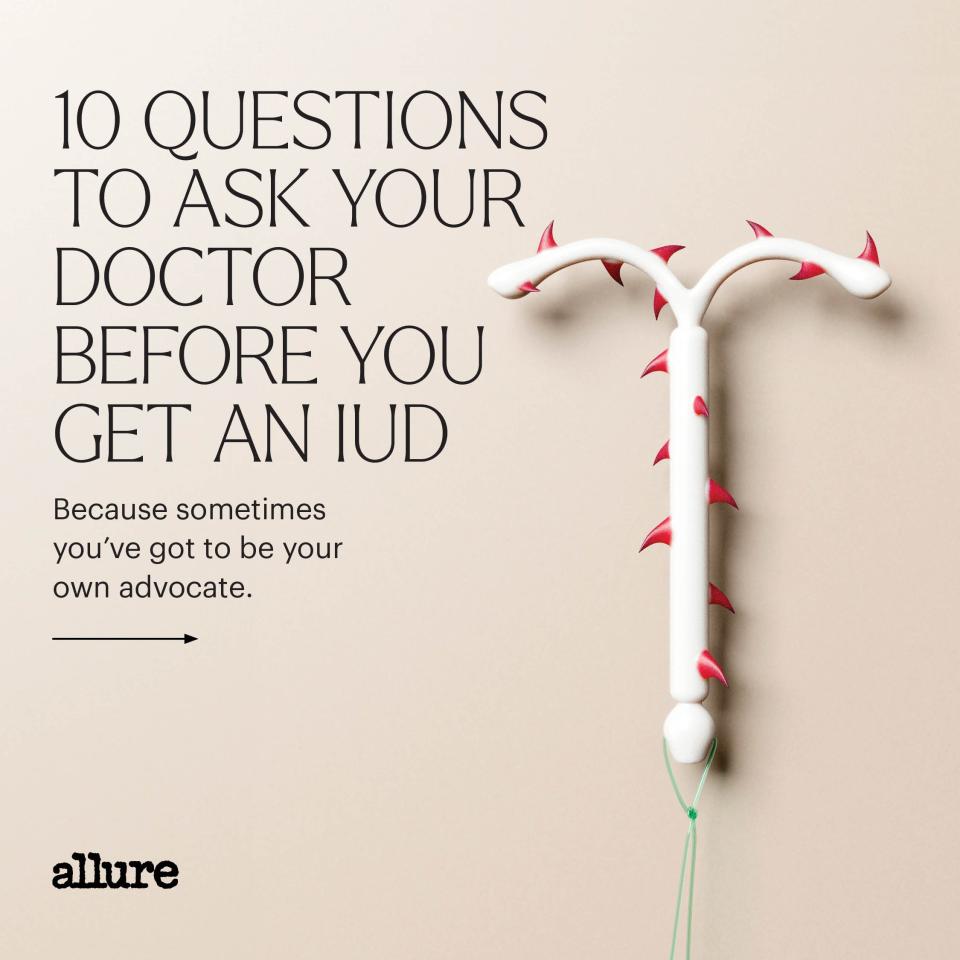
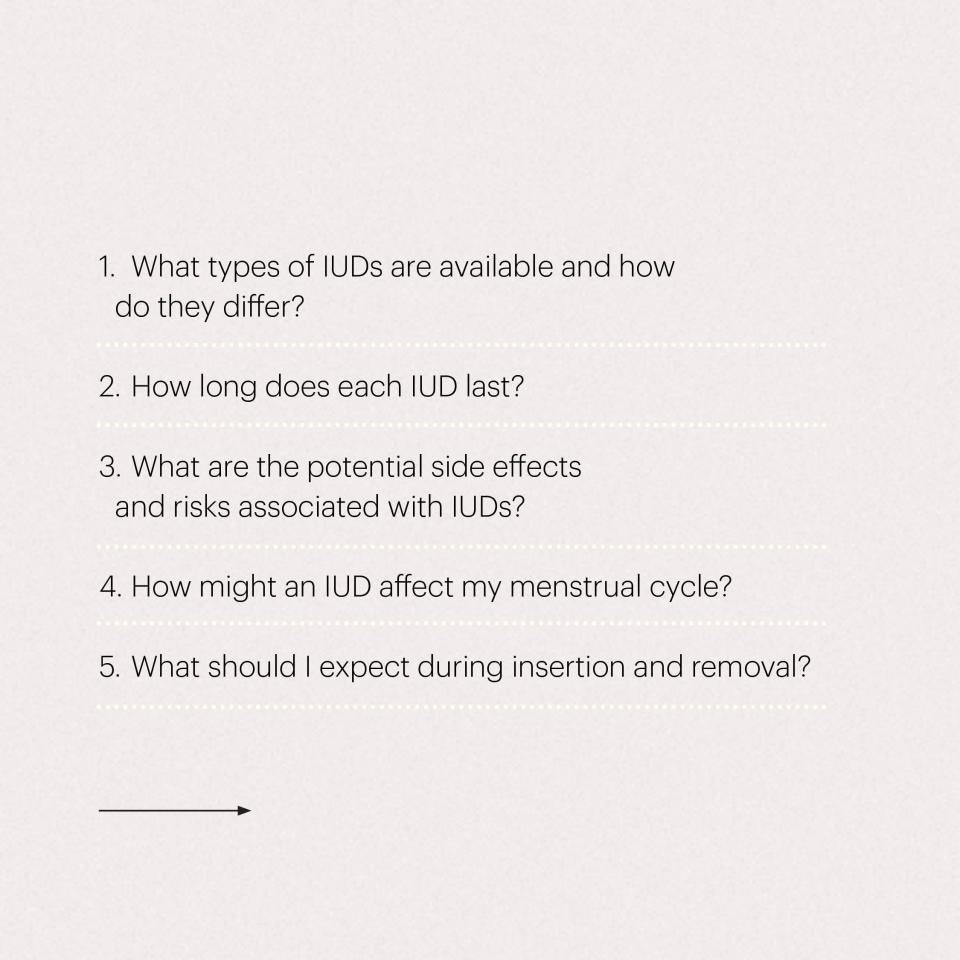
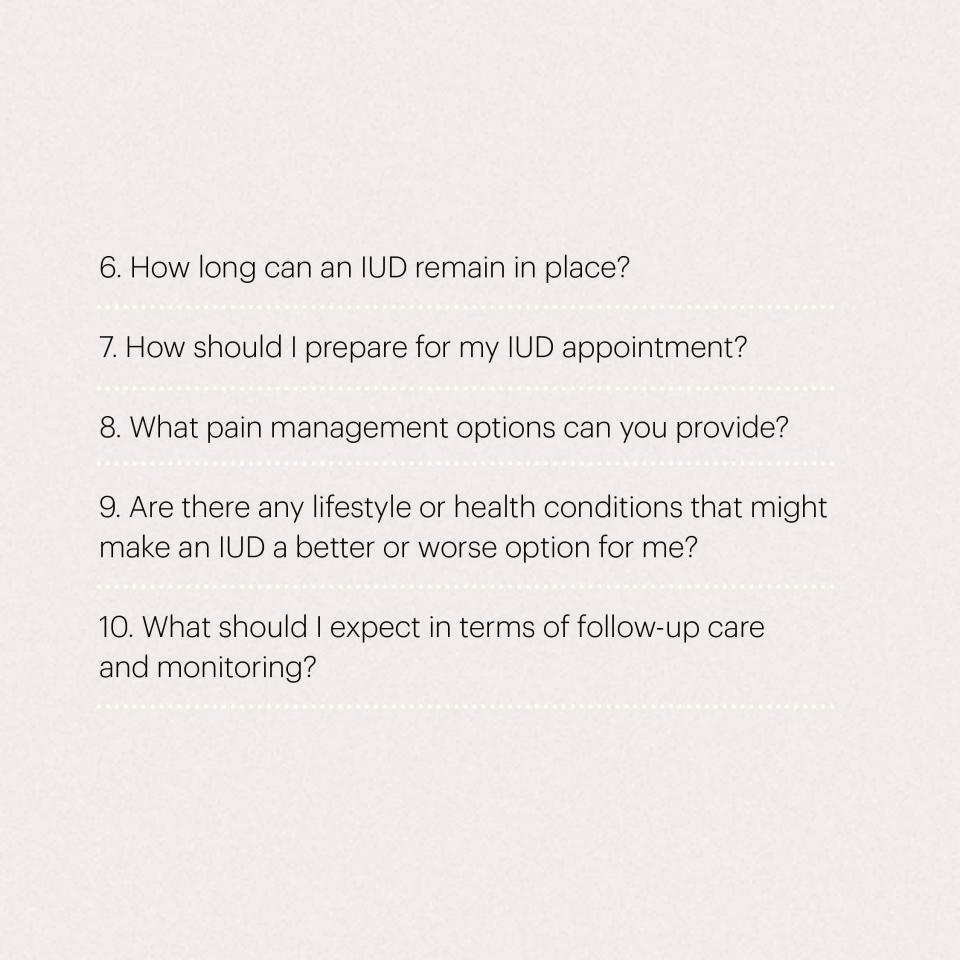
COURTNEY A., 35, New York City
“IUDs have provided me with a level of safety and freedom that, most of the time, required no thought.”
I heard about IUDs in my sophomore or junior year of college about 15 years ago. I was really interested in women's health and I shadowed an ob-gyn at a renowned hospital who saw IUDs as a women's empowerment issue. She thought that IUDs give you a level of freedom that other types of birth control don't.
I wanted to prevent pregnancy, and as someone with chronic migraines I was afraid of headaches, so I went with the nonhormonal option, the Paragard, which I ended up having three times.
My first Paragard lasted for four years before I started to feel something was wrong. I was running more and I noticed I was feeling some pain. It was inconsistent, but I was also noticing some spotting. I saw my doctor three times over a year and each time I felt like I was being brushed off. I asked, “Can I get it checked?” They said, “No, we don't do that. You're probably dehydrated.” The last time, I asked them to document the pain in my chart.
Three months later I was still having this pain, so I went back to my doctor to get it checked. Because I wasn’t due for a pelvic exam, I was told I’d have to pay out of pocket. So I pushed them to give me an STI test, which I knew would be covered. My doctor didn’t even do the STI test because as soon as I got into the stirrups she saw that my IUD was hanging out of my cervix. That was the first time she had believed that I had a problem. Within an hour, my IUD was taken out completely.
I still wanted an IUD to prevent pregnancy, so I got another one a few weeks later with the same ob-gyn and it lasted for eight months. It was never comfortable. I was bleeding even after three months, so I went back and had an ultrasound and my doctor said it looked tilted—prompting her to remove it.
And then a month later, I got another Paragard. For my last Paragard and my Skyla, I found a new ob-gyn—and I like her. She’s great. There was a level of comfort I had with this doctor putting in my IUD. She wasn’t phased by the fact that not all uteruses are perfectly symmetrical. She was focused on the person in front of her, not the theoretical diagram she learned in school.
She’s an Asian woman and I’m a Black woman. And now I don't actually see any white practitioners. They're all women of color. I think that matters. Each time I see her, I feel heard. Her advice reflects my needs and wants. The previous three practitioners who either inserted the IUD wrong, or wouldn't listen to me, were all white women. I think that my experience demonstrates what I think is real, that clinicians are not looking at women of color as they would themselves, and the pain that would cause them to make certain treatment decisions are different for us.
My new doctor inserted my last two IUDs, a Paragard that I had for six years and now the Skyla, which I’ve had for almost two years. Because my migraines have been under control, I felt liberated to use hormonal birth control. I'm actually scheduling an appointment with her in the coming weeks to remove the Skyla, but only because I’m thinking about getting pregnant.
I've had a wide range of experiences with my IUDs. They have provided me with a level of safety and freedom—particularly as a woman dating in New York City—that most of the time required no thought. My IUDs gave me a level of control that no one could take away. Now, I can have intentional conversations about being pregnant when I'm ready and comfortable.
ARIELLE T., 35, Santa Monica
“This is a great form of birth control.”
I got a Mirena after having severe reactions to the Nuvaring. [Editor’s note: A Nuvaring is a flexible vaginal ring that releases hormones to stop ovulation and prevent pregnancy.] My endocrinologist recommended [an IUD] because of its use of low (and localized) hormones. The process of getting it was painless and I didn’t take any medication prior to help with discomfort. I have a high pain tolerance. I actually found my pap smear to be more uncomfortable than the insertion of an IUD.
I experienced very slight cramping immediately after insertion that didn’t last, which I was grateful for. The entire time I had the IUD, my period was extremely light and almost nonexistent. I barely needed a pad or tampon.
After five years, I had the Mirena removed, which was uncomfortable, and in just two weeks I found out I was pregnant. Everybody’s body is different, of course, but for me this is a great form of birth control. I really see no downsides other than slight discomfort during removal.
JESSICA G., 29, Brooklyn
“I legitimately saw stars like a cartoon character.”
The anxiety of potentially getting pregnant ate me up in my early 20s. I felt like I wasn’t protected enough while having sex even if I was on the pill or using condoms, so I got an IUD.
My provider didn’t brief me on how painful it could be, so leading up to my insertion I was like, “Oh my gosh, I'm doing something so good for myself.” I was so naive. I thought it was going to be so quick and easy.
As it was inserted, I legitimately saw stars like a cartoon character. I was nauseous. It felt like I was having the worst period cramps of my life—multiplied by two. The pressure of my insertion triggered bowel movements so I ran to the bathroom in the most miserable pain I've ever been in. I sat on the toilet, clutching a water bottle my doctor gave me like a stress ball. It didn’t help with the pain. Ultimately, I had to call my parents to pick me up from my appointment.
Yes, it sounds daunting. But getting an IUD was one of the best decisions I've made. The pain I went through during my insertion was so worth not having that apprehension loom over me for the last four to five years. It changed my life. I recommend getting an IUD to anyone who might be nervous about getting pregnant. I found it to be a responsible decision for both me and my partner.
JILL B., 51, Philadelphia
“They start looking for the IUD. They’re looking. And looking. It’s not there.”
I got my first IUD after my third child was born. My husband and I agreed that we didn’t want more children. But he wouldn’t get a vasectomy. I don’t even remember why he wouldn’t. I was 37, and hadn’t taken the Pill since before I got pregnant with my first child. I didn’t want to go back on it. My doctor recommended a nonhormonal IUD. The insertion process was basically nothing. I honestly have no memory of it, so it couldn’t have been very uncomfortable.
I have a vivid memory, though, of a summer day a little over three years later when I realized I was feeling kind of off. The same kind of off I felt in the early days of my pregnancies with my three children. A friend said, “Just take a pregnancy test. You can’t be pregnant but it’ll give you peace of mind.” The test was positive. I remember getting in my car and, like a bat out of hell, driving back to CVS for more tests. I ran into someone I knew there and told them what was going on and they said, “The positives do not lie. You're definitely pregnant. I was devastated.” I did not want a fourth child. My youngest was just potty-trained, and I was starting to see the light at the end of the tunnel.
I called my doctor and he said, “You need to go to the ER because most of the time if you have an IUD and you get pregnant, it's an ectopic pregnancy and that can be dangerous.” He also said that even if it wasn’t an ectopic pregnancy, when they took the IUD out, there would be a very high chance that I would miscarry. So I’m thinking, “Okay, this will probably just resolve itself.”
My husband and I get to the ER. They’re doing an ultrasound. They see the baby’s heartbeat; it’s in my uterus where it should be. And then they start looking for the IUD. They’re looking. And looking. It’s not there. After that, I had two other ultrasounds during my first trimester to try to find the IUD; no one could find it. I didn’t miscarry.
I didn’t want to be pregnant, but I didn’t consider ending the pregnancy. I was bitter at my husband for not getting a vasectomy, though. And angry at the doctor who’d put in the IUD. He said, “Well, I told you to check the strings every month to make sure it’s still there.” I wanted to punch him in the face. Don’t you think I would’ve remembered him telling me that? I would have. And then I would have checked the strings. The only thing I can think is that it fell out. Maybe I’d had a little too much to drink one night and it just dropped into the toilet and I somehow didn’t notice?
Now, I can’t imagine not having our fourth child. He completes our family. After he was born, I had my tubes tied.
EMMA Z., 25, Denver
“Demonizing birth control is a trend right now, but not being on birth control wasn’t right for this stage of my life.”
It took me a while to decide I wanted an IUD. Demonizing birth control is a trend right now, but I had to accept that not being on birth control wasn’t right for this stage of my life. I had a boyfriend and I was having sex frequently and my period was already irregular. I wanted an IUD for peace of mind.
I decided to try to continue being hormone-free with the copper IUD, as I didn’t love my experience with the daily birth control pill. I was incredibly nervous for the insertion as all you hear are horror stories, but the appointment was super quick, surprisingly. And painless. At most, I felt a little bit of pressure. I was offered no pain medication, but took 800 milligrams of ibuprofen about an hour before. What I remember most was the doctor measuring the inside of my uterus, which was weird to feel as I was suddenly super aware of where my uterus is within my body.
About eight hours after the insertion, though, I was in immense pain. I had uterine cramps that were so intense and lasted so long—I thought I was going to pass out. I was able to make it through the night with more ibuprofen and a heating pad and the pain was gone by morning. I even had sex the next day and it was painless.
Two years later, I still have my copper IUD. I love this thing and I love that I don’t have to get it replaced for years or worry about pregnancy. I’ve enjoyed this method and I find it nice to still feel the natural ebb and flow of my cycle.”
LAUREN B., 40, New York City
“I eventually passed out from the pain.”
I heard about IUDs from good friends of mine at a dinner party. I think there were at least three women who were talking about how much they loved their IUDs, saying, “It hurts during insertions, but it’s so worth it.” So I made an appointment for a hormonal one. I thought it was the best choice for me because I’d heard it was flexible and I had already been on hormones from taking the pill.
I didn't have trepidation going to my appointment. I usually face situations with a vigorous energy, ready to tackle them. But when I walked into my room, I felt a little unprepared. I was surprised to see so many people. There was a doctor and two or three nurses. The room was also a little more surgical than I’d expected.
I wasn’t prepared for how much it would hurt. I was sweating so much and I eventually passed out from the pain. When I came to, someone tried to give me an apple juice box, and I heard one of the nurses make fun of me. She goes, "Oh, you can tell she's never had children." I already felt embarrassed for passing out, and hearing that comment made it worse.
I had pain for about a month, which eventually turned into a dull ache. Sex with my new partner was also painful, so I decided to take it out a year and a half later and when I did, my doctor told me that my IUD had been sticking sideways into my cervix!
I have friends who love their IUDs, but I feel like it just didn’t work for me. Maybe it's just the way my body is shaped, the way my cervix is shaped…but having it improperly inserted has scared me off ever getting an IUD again.
VALERIE A., 59, Albany, Georgia
“The insertion was painless. I wasn’t offered anything for pain.”
I used an IUD throughout my reproductive years. I had a total of three placed—one after both of my pregnancies and one during perimenopause to reduce the heavy menstrual bleeding that sometimes can occur.
I first heard about IUDs when I was in medical school, studying to be an ob-gyn. I wanted a long-term birth control method, so I thought this would be the best choice for me. I've done every birth control under the sun: I’ve had diaphragms, I tried the pill, but I wanted something that was long-term and something that I didn't have to think about because I was married and I was in school. I already had one child while I was in medical school and didn't want another child until later on.
It was 1991 when I got my first one—the Paragard, the nonhormonal, copper IUD—and I had it until 1996. I took it out to have my second child.
The insertion was painless. I wasn’t offered anything for pain, but my doctor recommended I take a Motrin and I did. It felt like a pinprick—a very small sensation—and I didn't have any problems at all. All of my experiences with IUDs were like this. I don't know if it helped that I had so much knowledge and I was like my own patient advocate, but I didn't really have any problems at all—no bleeding or cramping.
My second IUD was a Mirena, which I got in 2001. I’d switched [brands] because one of the benefits of Mirena was decreased menstrual bleeding, and I wanted to take advantage of that. I eventually didn't have any cycles at all, so that was a plus for me—and when it was time for it to be replaced, I did. I had the third IUD while I hit menopause and recently had it removed.
I would say, as far as birth control methods go, the IUD was the best option for me and my needs—and I highly recommend it. There are some factors that you have to consider, like your lifestyle. You don't want to be someone who has multiple partners and all this kind of thing because the risk for infection can be high—but if you fit all the parameters for an IUD, I think it's a great way to go.
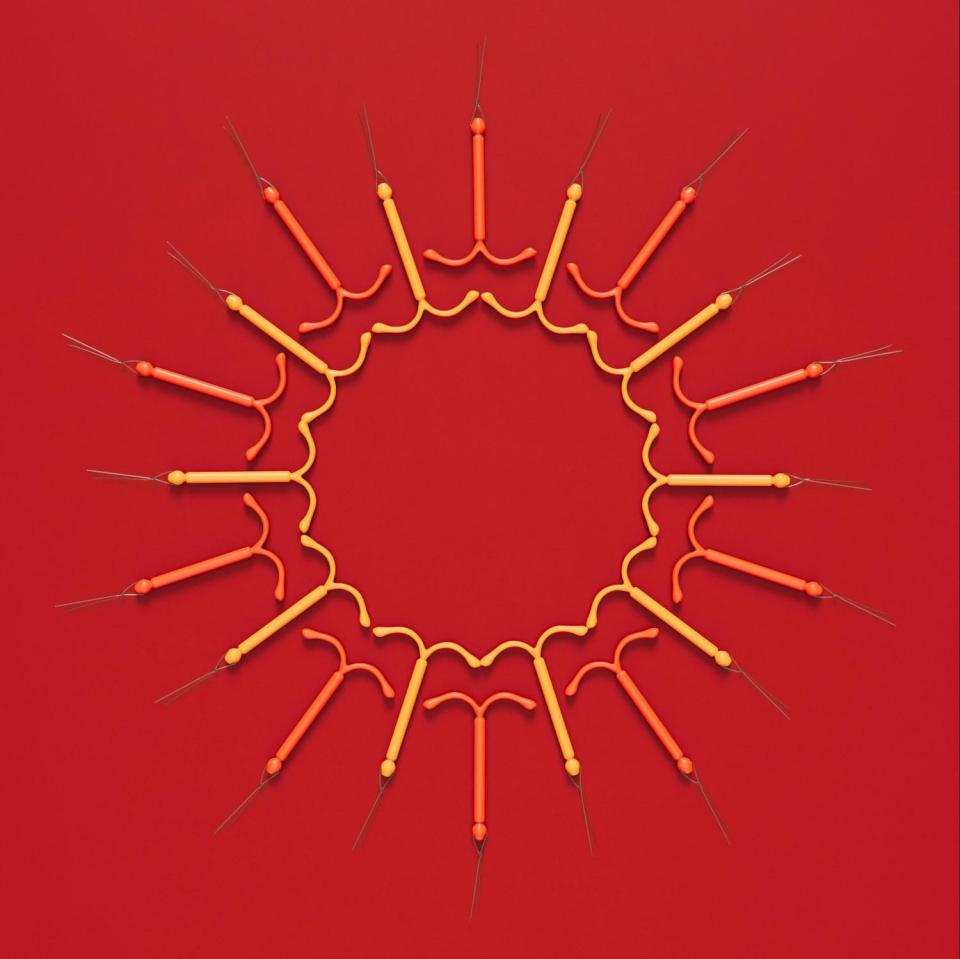
MORGAN T., 32, New York City
“I don’t want to think about the fact that I have a uterus.”
I am a trans man and I got an IUD about two months ago. I had been on oral contraceptives for about seven years and then went off of them because I didn't really need it; I was not sexually active with people who could get me pregnant. That changed over the last year and I talked with my doctor about birth control options.
Taking oral contraceptives every day is something that I could do and be compliant with, but it made me feel uncomfortable. I don't like thinking about the fact that I have a uterus every day.
Every trans person is unique and we all have different experiences, but for me, having a uterus is dysphoric. It feels foreign to me. I don't want to think about the fact that I could get pregnant. I don’t want to think about the fact that I have a uterus.
An IUD felt like a longer-term solution to birth control that could minimize any sort of periods or bleeding that I may have, while preventing pregnancy. A lot of people don't know that when you're on testosterone, you can still get pregnant.
Also, I am primarily sexually active with gay men, and it is not a fun experience to have to explain to a gay man why I'm bleeding. It affects my sex life, and while most of the folks that I'm engaged with and spend time with have done their own work about gender and are accepting and understanding, it's not fun for me.
I got the Mirena, which [secretes] localized hormones, because my doctor said it wouldn't interfere with my systemic testosterone. I'm very, very fortunate that my primary care provider is actually a trans man. It is a thing that I feel a little bit of guilt about because I know so many trans people struggle to even feel safe in a health-care environment. The more people we have who go into health-care professions who are genderqueer in some way, the safer it is for the rest of us. My doctor referred me to a gynecologist to have an IUD consultation. The ob-gyn was a cis man who has had some exposure to trans patients, but not a lot.
In no way was he not supportive. He was very affirming, but he didn't have a lot of information to give me about which IUD is best for someone in my situation. And so he basically presented me with options and said, “Here's what we know, when I'm recommending this to someone who's not on any sort of hormonal replacement therapy. Here are the risks involved.” I had mentioned to him that I know people who had had IUDs who are trans men, and he said, “I really recommend you probably talk to them as well about what it was like.” That was pretty emblematic of my experience with medical professionals and most other trans people that I know.
The insertion was 10 out of 10 painful, but I’m glad I did it. The experience has been more uncomfortable than I expected. I have had a lot of cramping and bleeding, but I'm trusting that it will continue to decrease in intensity.
I move through the world in a way where I don't engage with the idea that I have a pregnancy risk very much. But taking daily oral contraceptives [forced me to]. It’s wonderful for some people. It is just not right for me. The IUD is a reliable solution for contraception that doesn't involve that type of reminder every day.
PIA V., 32, Hoboken, New Jersey
“It hadn't properly attached to one side, so it was dangling inside of me.”
I was a sophomore when I first decided to get an IUD. I went to my university’s medical center, which was a teaching hospital. My doctor asked me ahead of time if I'd be comfortable with students watching, and I said, “Yeah, of course. We're all adults. If they can get a learning experience out of this, I'm fine as long as they're not the ones inserting it.”
I feel like I probably should have been informed that my procedure would take longer, being that a teacher was going to be showing students how to perform it. My doctor explained every single step and asked her students to look on and ask questions while I was in the absolute most excruciating pain I had ever experienced in my life.
Typically, when you feel pain, you want to squirm, move, or be able to have knee-jerk reactions. But I was putting all my brain power into not moving and trying to be as easy as possible. Part of me didn't want to seem like a wimp in front of this group of people. I lay there grinding my teeth and just breathing in and out and hoping it would all be over. Every time a student asked a question, I was like, “Oh, my God, you've got to be kidding!”
A few weeks later, I went back to the student health center and told the team, “Hey guys, something is up with my IUD. It's painful, I can feel it, my partner can feel it. This isn't right.” At first, they blew it off. They asked me what his size was and I was like, “That is definitely not the issue.” I was adamant about being seen. I told them I wanted it removed and to get another form of birth control. They reluctantly sent me to get an ultrasound and saw that my IUD had never traveled up, which meant that it wasn't effective and that I could have gotten pregnant during that time. I was so lucky that I didn't.
They also saw that it hadn't properly attached to one side, so it was dangling inside of me. My doctor told me, “Oh, actually this could fall out at any moment, so we need to get you in to get this removed ASAP.”
I was mad because I realized that I had been misled every step of the way. I wasn't told how much it would hurt and how much longer the insertion would take when I consented to letting students watch. I wasn't told that there was a risk that the IUD may not travel as it's supposed to.
All I knew was that I had been lied to, that there was a medical device lodged in my vagina, and that it hurt. I was scared that with the friction of having had sex, I may have caused irreversible damage that would complicate pregnancies down the line. As someone who has always known I want to be a mother one day, this struck a deep fear in me that continues to this day. I didn't feel like I could trust my doctor to tell me the truth about the consequences of this outcome because I had already been lied to by omission throughout the entire experience.
A day later, I had the IUD removed at an ob-gyn office I was referred to. I remember being nervous, having cold sweats, and thinking, Oh, my God, I'm going to experience this pain again, and then being so relieved that this doctor was in and out in like 15 seconds.
My advice to someone who is getting an IUD is to go to a doctor that you trust. Know that at a teaching hospital, the doctors will take their sweet, sweet time. I would also suggest taking any type of pain medication you can beforehand and to listen to music so you don’t hear anything—like the clamps of the speculum. If you're going to do it, just try to distract yourself as much as possible because it will likely be painful.
GLORIA Y., 38, Los Angeles
“I am worried about access and affordability to birth control again.”
I got my first IUD in 2016 after Donald Trump was elected president. I feared that my access to birth control could be limited, and I knew I didn’t want kids in the next five years.
It was first inserted at a clinic with no anesthesia. It was painful—like an intense pinch in my stomach—but bearable. It came out on its own sometime in 2019 and I didn’t know it was gone until my check-up in 2020. (My ob-gyn and I deduced it had been gone for about a year, based on the fact that I started menstruating regularly again during this time.) My doctor said it likely came out during a bowel movement when I was on my period and I had to get an X-ray to confirm it didn’t migrate anywhere else in my body. [Editor’s note: Experts we spoke with say it's unusual but not impossible for an IUD to be expelled during a bowel movement especially if it's already become dislodged and moved into the vaginal canal. ]
Despite that experience, I decided to get another IUD. I went to a different doctor who offered me a numbing shot for my cervix so that I wouldn’t feel pain. This was game-changing for me. This time, I didn’t feel any pain during insertion.
Unfortunately, about three to four weeks later, this IUD also dislodged and I was in excruciating pain. Even worse, it was the Saturday of Labor Day weekend, so I couldn’t see my doctor to remove it right away. I ended up spending two and a half days with a stabbing pain at my cervix until I could see my ob-gyn.
IUDs aren’t right for me. My doctor agrees, saying that my body wants to reject them [for some unknown reason]. We explored other birth control options (like the arm implant) before I went back on the daily birth control pill. But with women's reproductive rights being stripped from state to state, Trump once again running for president, and the current conservative SCOTUS, I am worried about access and affordability to birth control again. I'm only able to get a three-month supply at a time—but who knows what will happen in the coming years?
NAYIRI K., 44, Boston
“I still think fondly of my Mirena.”
I have always had really long, heavy periods. Without [hormonal] birth control, my period lasted at least two weeks and came with heavy cramping and mood swings. I couldn't tell you how many pads or tampons I went through. It made me anemic, so whatever I could do to shorten the periods, I would.
When I was in my early 30s, after trying a lot of different oral birth control options, my doctor suggested an IUD, specifically, the Mirena. She prepped me for my insertion appointment by writing me a prescription for misoprostol—a pill that was meant to be inserted into my vagina to help soften my cervix and make the procedure easier. She also told me to take some Advil at home. The insertion process itself was very difficult for me because I was very stressed out and nervous. I'd never done anything like it. My nurse said, “I will sit with you and hold your hand, if you need it.” I consider myself to have a pretty high pain threshold, but I definitely needed to hold her hand.
I bounced back quickly after my procedure and for the first few weeks of having my IUD, I kept looking at the calendar and just wondering, Am I going to start bleeding at any point? I always made sure I had a panty liner or something with me, just so I was prepared. Around the time I’d normally start bleeding, there was nothing. Absolutely nothing. I felt great. Thanks to my Mirena, I immediately stopped getting periods for the next six years. This was miraculous. I wanted to toss Mirenas off of the rooftops like confetti. IUDs for everyone!
When it was time for it to come out, I decided to get another one because I liked it so much—but that’s when things started to get complicated. This Mirena caused cramping and bleeding after sex. So I went to my doctor and we did a vaginal ultrasound to make sure it was still in the correct place. She said it was, but since I was having trouble, she suggested we take it out and try again. I replaced it after having it for just four months, but the same thing happened with my third Mirena, which prompted me to pause birth control to let my body reset.
With my fourth Mirena, my periods became more erratic. That's when my doctor and I started doing more tests and we found out that I’d always had small fibroids that were growing rapidly, pressing on my cervix, and causing lots of other issues like irregular bleeding.
As far as I'm aware, my doctor didn't believe that the Mirena did anything to speed up these fibroids. My mother had a history of fibroids, so perhaps it was genetic. I had a very large one that was sitting on my cervix, and my doctor’s theory was [the fibroid] had been making it difficult for the Mirena the second, third, and fourth time around.
I think my body just became inhospitable to a Mirena and only hospitable to fibroids. But for a short, glorious period of time, the Mirena and my body got along really well together. I still think fondly of my Mirena. My first one truly was a game-changer. I felt very free and comfortable to do whatever I wanted to do without feeling that I’d have to plan around a really long and uncomfortable 10 days every month. I suggested it to friends because if it works for you, it works really, really well.
DANA O., 38, Philadelphia
“I believe that as a Black woman, the pain was greatly downplayed and ignored.”
My focus on protecting my sexual health blossomed during college as I met more young Black women who were using different forms of birth control. However, it wasn’t until a year ago, after deciding that I was 90% “one and done” with having children that I decided to make the switch from the pill to an IUD.
I researched IUDs for at least four months. This included reading medical papers, studies, brochures, and news articles detailing firsthand accounts. I talked with my closest girlfriends about my interest in an IUD, including one of my best friends who is a registered nurse. Then I made an appointment for a consultation with my gynecologist and we discussed the pros and cons of an IUD, brands that are available, the insertion and post-insertion processes and, most importantly, why I was making the choice to switch to a different form of birth control. My doctor explained to me the potential pain that would occur during insertion and reassured me that since I had an unmedicated, unassisted birth, “You’ll be fine.”
However, that was far from the reality. The discomfort I felt during the insertion process of the IUD was worse than when my son was actually descending into my birth canal. I had discussed with the doctor who performed the in-office procedure my pain tolerance levels and she was confident that I would feel nothing after learning about my easy labor and birth process. But I believe that as a Black woman, the pain was greatly downplayed and ignored. I wish that there was more transparency on what it could feel like and that it is equally a part of the education process on IUDs.
It took nearly a year for me to feel “settled” with the IUD. I decided to keep it because I no longer have to be concerned with taking the pill daily. It's a very effective form of birth control and lowers my risk of getting cervical cancer. And as someone who has been diagnosed with high-grade precancerous cells on my cervix, the IUD is a good option for me. I really feel comfortable knowing that it’s there and I don’t have to really worry about it.
LIN C., 34
New York City
“I found that communication helped with my discomfort.”
I learned about IUDs from my ob-gyn when I was 23. I was looking for an alternative to the Nuvaring because I kept forgetting to put it back in after having sex. [Editor’s note: Experts do not recommend removing the Nuvaring during sex. However, the hormones it emits protect against pregnancy for up to three hours, even after the ring itself has been removed.] I wanted something I could easily forget about and the Mirena was covered by my insurance.
I was nervous on the day of my appointment. I have a low tolerance for pain and my doctor had warned me that I’d feel crampy and uncomfortable for a few days. I took Motrin, but I still felt cramps and dull aching during the insertion. The doctor had explained every step and would tell me what he was going to do before he did it. I found that communication helped with my discomfort.
I had my second IUD—a Liletta—up until a few weeks ago, as my husband and I hope to conceive. If you're looking for a low-hormone birth control option, I’d say the IUD is the way to go. I never really had side effects that I experienced when on other birth control options. I didn't gain weight, was not hungrier than usual, didn't experience heavy periods, and I loved that I could easily forget about it. If I were to go back on birth control, I'd opt for the copper one, as I do not want to put more hormones in my body.”
EMILY L., 29
Tallahassee, Florida
“The nurse seemed annoyed and tried to gaslight me, saying, ‘It’s not that bad.’”
I never actually got my IUD because my insertion appointment went so terribly. I was trying to get the Kyleena when I was in college in 2017. It seemed like the best option for me at the time, since I knew it would be several years before I would want to have children. My doctor had been pretty persuasive, saying how it was an easy, painless form of birth control I didn’t have to worry about for years.
The insertion process was miserable. Before going in for my appointment, I had read a lot about what to expect and took two ibuprofen. A nurse first used a metal tool to attempt to measure my cervix. I immediately started cramping and felt extreme pain. I got lightheaded and asked my doctor to stop, saying I didn’t think I would be able to complete the process. The nurse seemed annoyed and tried to gaslight me, saying, “It’s not that bad,” and “Everyone in the office has done it with no issue.”
I was incredibly embarrassed and started to tear up. At the time, I was especially shy and rarely spoke up for myself, so it was hard for me to even voice my discomfort to begin with. To be met with her reaction was very discouraging. She left the room and returned with another nurse who asked if I wanted to try again. When I said no, she suggested I talk to my doctor about getting anxiety medication and then try to come back.
I’d recommend that anyone interested in the IUD do their research on their providers. I am almost positive I would have continued with it—and actually gotten the IUD—had I been at a different provider who respected me. Even if it was the same painful experience, I may have gone back and tried again if they didn't make me feel so embarrassed about my reaction.
ROSA P., 24
Brooklyn
“I got one begrudgingly because I felt as though my future needed to be protected.”
I decided to get an IUD for two reasons: I did not want to get pregnant anytime soon and my ob-gyn said an IUD could help with my nauseating period pain (her logic was IUD equals no period equals no pain) and ovarian cysts. My insertion appointment felt complicated and longer than it should have been. Getting a pap smear is already uncomfortable and painful, so having the speculum open me up for an even better view of my cervix was exhausting. I felt so exposed.
For a month and a half after the appointment, I bled and bled and bled. After I got my IUD, I developed more ovarian cysts and sex became painful.
My current gynecologist, who I started seeing about a year and a half after I got my IUD, told me she could not comprehend why I had Mirena as someone with a history of ovarian cysts. My jaw dropped. I saw four to five other gynecologists between the doctor who inserted my IUD and my current ob-gyn and none of them had told me ovarian cysts [which I was already predisposed to] were a common side effect.
I no longer have my IUD, and looking back I felt like I got one begrudgingly because I felt as though my future needed to be protected—especially in the current political climate around reproductive rights. There’s a bitterness about having to go through something this traumatizing.
My advice for anyone who is getting an IUD would be to remember that one gynecologist’s opinion does not mean everything. Get multiple opinions. Go with who you feel is listening to you.
MACKENZIE D., 29, New York City
“Both experiences were brutal—downright barbaric.”
I have now been through the IUD insertion process twice. Both experiences were brutal—downright barbaric. I remember feeling faint and the blood draining from my face as my first IUD was inserted. For my second IUD, I nearly vomited from the pain. After all was said and done, my doctor said, “It’s ridiculous, isn’t it? I would love to give my patients pain meds for this.” I've recently heard some lucky people have had their providers offer lidocaine. Jealous!
The crazy thing is that I still recommend getting an IUD to every single friend who has asked me about it. It's given me lighter, more regular periods and I've had few, if any, physical side effects. I love the peace of mind it has afforded me. It has been freeing.
MARIA D., 34, New York City
“If something doesn't feel right, speak up.”
I have had two IUDs—the Mirena and the Skyla. Mirena came first. The insertion for both was deeply uncomfortable. I had no pain medication, and when they clamped on my cervix, I broke out into a cold sweat and thought I was going to faint. I had to take off work for two days because of cramps and discomfort. All was well until my first period. Two days before my period started, I got the most intense cramps of my life. It felt like someone was twisting a knife in my uterus. I was brought to my knees; I had to lay on my stomach and scream into a pillow. I haven't had children yet, but if that's what labor is like, I'm a little terrified.
When I asked my gyno about this, he brushed me off and said that it was likely my body getting used to the IUD. But it continued for a year and every few months I'd check in with my gyno and get the same answer. Finally, after a year, I got the IUD removed.
Two years later, I tried again with Skyla, which is smaller—I thought that would help. By this point I had a new gyno who closely monitored the situation. It was placed (again, no pain meds) and like clockwork, the cramps returned. I tried to keep it in for six months, but only made it to four before I got it removed. Now I've sworn off IUDs, which is difficult because hormonal birth control pills are not an option for me because I get migraines with auras—and mini-pills [progestin-only birth control pills] left me with monthlong periods. I'm currently not on any birth control and it feels really unfair that the typical modes of family planning aren't available to me. Although I recently got married, we're waiting a bit to start trying to get pregnant and it still makes me laugh that I need to ask my 39-year-old husband to put a condom on during certain risky parts of the month.
After everything I've been through, though, I would encourage people to use the IUD, but with some caveats. The most important thing is to ask questions of both your doctor and of friends who have had the IUD. I email my doctor all the time. She's probably sick of me by now. But the way I look at it, I have a right to get answers to the questions I have when it comes to my body, so I never feel strange about asking them. I'd also consider your previous relationship with birth control. I have had a terrible time finding a solution that works for me, and so I go into every new experience a little wary because I know my own body.
Which leads me to my final point—listen to your body! If something doesn't feel right, speak up. If you got the IUD placed two weeks ago and you're experiencing pain, flag it to your doctor. And if they tell you to wait it out and that doesn't feel right, advocate for yourself. At the end of the day, you are the person living in your body and you deserve to be comfortable in it. In this case, that is more important than what your medical provider may suggest.
MARI H., 37, Atlanta
“Why not prepare a patient properly? Why not show any sort of empathy?"
If the removal process is anything like the insertion process, I plan on dying with my IUD still inside me. Not really, of course. I will obviously have it removed, but I do not look forward to that day. My doctor and NP told me that I could expect some pressure and a slight pinch, and that the process would be quick and pretty much painless. Instead, the insertion process was intense, painful, and emotional.
I have one child, who I gave birth to 15 years ago. Some of the pain that came with the IUD insertion was similar to how things feel post-birth. The main difference, though, was that when I had my daughter I had an epidural. With the IUD insertion I had only taken two ibuprofen. There was a lot of blood. Before I left the room, all they gave me was a pad to put on, and that was that.
I bled for two days. The pain felt like my lady innards had been mixed with a hand mixer, then ripped out of my vagina. But after that, there were no other side effects. That's been the silver lining with Mirena.
Though the physical pain subsided, the emotional and mental pain from the whole experience have stuck around. I am not a dramatic person: I am very objective and deal with things calmly and logically. Nothing about that process made sense to me. Why not just be honest? Why not prepare a patient properly? Why not show any sort of empathy? It was a cold experience and I'm so sad that women have to go through it alone.
LILY F.*, 30, New York City
“I felt bad for not ‘loving my IUD’ the way everyone else around me seemed to.”
I have endometriosis [a condition in which tissue that is supposed to grow inside the uterus grows in other parts of the body, like the ovaries or fallopian tubes] and adenomyosis [a condition in which tissue outside of the uterus grows into its muscular wall]. In August 2022, I switched from a low-dose combination birth control pill to the Liletta IUD at the recommendation of my gynecologist, who said it could help with symptoms like bladder pressure during ovulation.
While I was fortunate to have a pretty seamless insertion (I was knocked out for a simultaneous removal of endometrial polyps), I had an awful experience in the following months. My body looked and felt unrecognizable: I stopped fitting into my clothes and felt physically unwell all of the time. My periods were worse than when I wasn't taking any form of birth control. I'd get random, severe cramps outside of my menstrual cycle, so extreme that, in one case, I almost passed out on the subway.
I had severe GI upset for the entire time that I had the IUD. Multiple medical professionals tried to convince me it was simply my endometriosis worsening. I gained upward of 20 pounds over six months, despite exercising up to three times a day every day with no dietary changes, and felt incredibly out of place in my own body.
I finally got it out in April of last year after months of debating the pros and cons and feeling bad for not “loving my IUD” the way everyone else around me seemed to. I switched back to my low-dose combination birth control pill and my GI upset resolved immediately. I lost the first 10 pounds in a matter of weeks without any lifestyle changes and 10 more over the course of a few months (and a bit more effort).
JAIME B., 45, Westfield, New Jersey
“Once the omnipresent bleeding and spotting subsided, it was fairly smooth sailing.”
I had heard about IUDs from friends of mine (and friends of friends) who were done with trying to get pregnant and not wanting to get back on a daily birth control pill. About 80% of them had pretty innocuous or positive things to say about the IUD. The other 20% had either horror stories or less-than-stellar experiences. But isn’t that always the way?
Once I got into the headspace that my husband and I were done trying to conceive more children (which, granted, took me a while to come to terms with), getting an IUD felt very matter-of-fact, given my age and the number of children we’ve had. It took about five months for me to get an appointment. My gyn is also an extremely beloved ob, and he was booked out for ob visits.
My appointment was quick and relatively easy. I had three of my four kids sans-epidural because there wasn’t time for one, so apparently I have a tolerance for pain. The speculum part was the most uncomfortable to me, but it wasn’t an overly painful experience.
I bled a lot—almost daily for about a month and change. I haven’t had a period with regularity for years because I was essentially pregnant or nursing [and not getting a period while I nursed and pumped] for seven years, so the constant bleeding was definitely a curveball. Thankfully, my doctor and many friends warned me that this might happen. There was some cramping that came with the bleeding in the very beginning. Once the omnipresent bleeding and spotting subsided, it was fairly smooth sailing.
The only thing that throws me is I don’t have a regular period like I did when I was on the pill. I never really know when I’ll get my period, but I have sort of gotten used to that. And truthfully, I likely only have a few more years of periods anyway before I transition into menopause.
Like everything in life, everyone has an opinion to offer, but choosing to get an IUD is highly personal. You do you.
AMY Z., 31, Brick, New Jersey
“When I pulled down my underwear, the whole IUD—strings and all—was sitting there covered in blood.”
I had two IUDs and both ended up being unpleasant experiences. My first was a Kyleena, which my body expelled just six months after I’d gotten it. I was at a party at a friend’s house and I suddenly got a really, really bad cramp. It probably lasted about five seconds. I remember thinking, “It’s over; that wasn’t so bad,” and because I was with other people at a party, I brushed it off.
Later that night, I excused myself to use the bathroom. When I pulled down my underwear, the whole IUD—strings and all—was sitting there covered in blood. I went to my doctor the next day and, after doing an ultrasound to make sure my uterus was clear of any other parts of the IUD, she inserted a Mirena. “Let's just go for the bigger one because then maybe it'll stay better,” she said. I had it for two and a half years. My body didn’t expel it, but I had sporadic cramping and breakthrough spotting the whole time. I chose to get it removed early, and when the doctor went in, she couldn’t find it. Ultimately, the removal of the Mirena had to be under ultrasound guidance because the strings were all coiled up and couldn’t be reached. [Editor’s note: Typically, the doctor can reach the strings and pull on them, causing the arms of the IUD to fold upward so the device can be removed.]
I am not sure how I feel about birth control because I think it causes a lot of problems for women. The answer to anything related to women and their periods is birth control: You have PCOS? Birth control. You have heavy bleeding? Birth control. You're cramping too much? Birth control. The whole answer is birth control. It makes me wonder, Is birth control the best answer or is it just a widely accepted answer? We have to be advocates for our bodies by asking questions and seeking doctors who will evaluate us as a whole to find the best solution.
ANNA D.*, 50, New York City
“I understand now that men never had to feel that kind of pain.”
I had a Mirena inserted after my first pregnancy in 2005 and kept it until I decided to try for a second child in 2007. After my second pregnancy, I got another Mirena, which will remain in my body until I reach menopause. It’s been a total of 18 years with IUDs—and overall, I am happy I got them, mostly because of the convenience they offer.
Looking back on it, I was not prepared for the pain of the insertion. I was surprised at the internal pulling and tugging. My doctor hadn’t spoken to me about it and I felt very ill-informed. Also, I saw on TikTok that now you can get a shot of lidocaine for the pain. I didn’t have any pain medication. I had no idea it was available. The pain was a 6 on a scale of 1 to 10, with 10 being excruciating labor without an epidural. I remember having discomfort and cramps that kept me from going back to work after the insertion.
I have a female ob-gyn now, but the one who inserted my first IUD was a man. I understand now that men never had to feel that kind of pain—that’s likely why there was no discussion about it or offer for any sort of medication to reduce the pain. I would highly suggest trying to get an understanding of what your appointment will look like before getting the IUD and advocating for pain medication if you think you’re going to need it.
SARAH H., 29, Brooklyn
“Almost a year later, I ended up being in the 1% who got pregnant.”
I came off of birth control pills at the end of college and was looking for nonhormonal alternatives that wouldn’t cause intense mood swings. I was also looking to regulate my body after being on oral contraceptives for cramps since high school. After asking friends and consulting with my doctor, I made an appointment to get the Paragard. It was painful—it felt like a very intense cramp—and I experienced painful cramps and more frequent, longer periods for months after I’d gotten it.
Almost a year later, I ended up being in the 1% who got pregnant. I was in shock, scared, and honestly so disappointed that I had taken the precaution to utilize one of the more “permanent” forms of birth control and it had failed me. I was 23, and my doctor told me my IUD had shifted. I didn’t feel it.
I had the IUD removed and got an abortion. My decision to get one was immediate. I was lucky to have a long-term partner who was supportive through the process and on the same page. In my own opinion (then and to this day), I was too young, not at all ready for that type of commitment, and [a baby] would not have been in any way financially feasible.
I utilized other forms of contraceptives before deciding to get another copper IUD in 2022, with the plan to be incredibly diligent about getting the strings checked by my doctor and cognizant of any potential signs of it shifting. Since then, it’s been completely effective, though my periods are longer and I get more intense cramping during my period.
COLLEEN R., 29, Portland, Oregon
“Since it’s expensive to buy tampons, I was also reveling in the savings.”
I started thinking about the IUD in 2016. I was living in Florida around the time of the Trump election. I heard speculation that there might be some overhaul in our medical system and I didn’t know what states would still cover certain services. I was also really young at the time and not ready to have children anytime soon.
About a year later, I ended up moving to Portland and getting the Mirena. I wasn’t nervous about my appointment. I do my annual appointments and I'm fairly used to the speculum. It's not pleasant, but I already knew what that feeling was like. My doctor also warned me that it might be painful and described it to me as intense period cramps.
I would characterize my whole process as a pretty privileged experience. It wasn't a fancy doctor or anything like that, but this procedure was covered by my insurance. I really liked my gynecologist, and it was a women-focused clinic. The rooms were really nicely decorated. I also had my partner at the time there with me. So with all those factors, it was anticipation more than nervousness. It didn't take that long. It didn't feel like I was going in for surgery or anything like that. It just felt like an ob-gyn appointment.
The first year was great because I no longer got a period. Because I’m really active—I camp and hike a lot—it's just really inconvenient to have periods. And since it’s expensive to buy tampons, I was also reveling in the savings.
The IUD was one of the best health-care decisions I've ever made. I always recommend looking into IUDs, but I know that they're not for everybody. My IUD offers me a lot of freedom, more than I had before. I'm a wishy-washy person in general, but the IUD was something where I was firmly like, Wow, I'm so glad that I decided to look into this.
Cassie Q.*, 33, Brooklyn
“What I didn’t realize was that it made me more susceptible to any infection entering my body.”
I had the copper, nonhormonal IUD—the Paragard—for nearly 10 years and loved it. I’ve never been on hormonal birth control and it felt like the easiest, most natural form of contraception, like I was in control.
However, the warnings include that you can be more susceptible to infections. I wasn’t worried, as I had the same partner for all of this time, so I knew I wasn’t exposed to STIs. What I didn’t realize was that it made me more susceptible to any infection entering my body.
In September 2022, a few months after my wedding, I was hospitalized for five days with an infection in one of my fallopian tubes. I was very sick and my medical team kept having to switch antibiotics to find the “cocktail” that would cure me.
The doctors cultured the bacteria but could never pinpoint what it was, nor the cause. They had a hypothesis: Perhaps the bacteria came from me swimming in the ocean a week prior or from the period underwear I’d been using.
Either way, they said having my IUD made me more susceptible to this infection. I had it removed. My fertility endocrinologist took a second look at my fallopian tubes, post-infection, and she isn’t convinced they are clear of residual scarring, which may be contributing to my fertility issues. Because of this, my husband and I are starting our first round of IVF next week, as my doctor thinks it’s our best chance to conceive. Would I still recommend the copper IUD to others? Potentially, but as with any medical device there needs to be more education for the patient.
CHERIE W., 36, Brooklyn
“I have a love-hate relationship with IUDs.”
I had my first IUD for five years without incident. In 2019, I had it removed and replaced by a doctor in South Carolina who, before doing the procedure, questioned why I, a 31-year-old unmarried woman, even needed one. The removal and insertion hurt so much that I was stuck in bed for the rest of the day in the fetal position.
Since then, at every annual gyno checkup, I’ve had my doctors question whether or not it’s still in my body because they can’t find my strings. It prompts them to do a painful exploration or ultrasound to find them (which they ultimately do). [Editor's note: The strings of an IUD should generally be reachable during checkups. If the strings aren't visible, your doctor might perform a pelvic examination or ultrasound.]
I have a love-hate relationship with IUDs. I love that I’m very unlikely to get pregnant and that my period is minimal. The anticipation of the painful annual checkup and my next removal, though, almost makes it not worth it. I’m debating if I want a new one and I honestly wish I had known more about the potential complications (and pain) before I got it inserted.
*Names have been changed for privacy
Illustrations by Justin Metz
Read more stories about reproductive health care:
Originally Appeared on Allure

